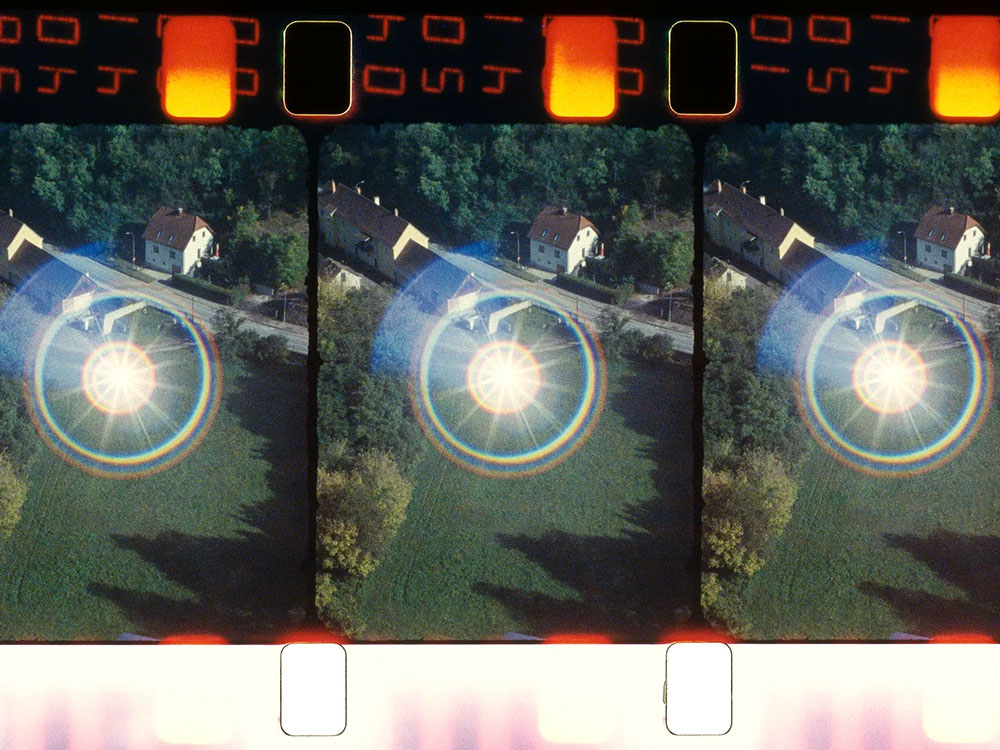Rooster at dawn (2023) plays on a loop opposite from the elevator that provides access to 99 Canal, perpetually announcing circadian shifts into light with a muted barnyard bird and lens flares like drops of dew. The next film trades the farm for the classroom, where a cassette unspools mysteriously. The illusion of Ghost tape (2021) is that a moving image of a cassette advancing is projected upon a static, empty cassette tape. In this piece, handheld camerawork examines the inanimate empty object and its convincing surface animation. Another especially alluring film, Solar farm (2023), uses a mirror and the sun to produce perfectly concentric optical flares which light up the room.
The fourteen films in Animal Farm, João Maria Gusmão’s exhibition at 99 Canal, are not conceived as a single work, and yet the impressiveness of the individual installations and their proximity to one another generates tension with how the works are supposed to be read with and against each other. My first visit left me wondering why the show was corralled under such a title. The exhibition materials, including a beautiful brochure by curator-cum-projectionist Marco Bene, do not clarify the connection between George Orwell’s 1945 novel and Gusmão’s work. Instead, they playfully catch Orwell’s book up with the present, inventing hybrid myths and neologisms along the way.
Located near the mouth of the Manhattan Bridge, 99 Canal is a non-profit space run by Baldassarre Ruspoli. It opened in 2022 and hosts artists for residencies and exhibitions. This project by Gusmão is the tenth that the space has hosted and it sets the sixth-floor Manhattan skyline into striking relief. Bedrooms (2023) is projected onto a small panel that seems to float within a window pane, such that the image of a nondescript hotel room and mirrored closet door become embedded into the buildings behind it. This is exaggerated with My uncle’s castle (2023), which shows Bene from behind as he looks upon a tourist billboard for a medieval castle.
Mustard piece (2023) is installed low in the corner of a room, as if someone left an illuminated square on the floor and propped it up against a wall. The work appears vintage, almost prehistoric. It is a fixed-view of mustard being extruded from a tube, but played in reverse. The glistening goop returns satisfyingly to the spout in an act Bene likened to “self-love.” A projection hanging above Mustard piece affirms that the works on view are as much about food and consumption as they are about animals.
Flat cows make nice yogurt (2023) is an anamorphic projection that spreads the broadside of a cow even broader. Shot with a lens that flattens and doubles the width of the image, and then projected with the same lens to make the image four times as wide, the film transforms a bovine representation into something else. At the press preview, the artist told me that the flattening paradoxically results in a sense of opulence. To me, it was like the cow became a unit of transportation, distended into the sturdiness of a subway car.
Thirteen of Gusmao’s 16mm films are projected as single-channel color loops without sound. The works criss-cross each other over the shabby floors and exposed-frame walls, weaving the exhibition spaces into a humming web of light. The fourteenth film, Fermented Foam (2023), is a microcosm of this. The film comprises three overlaid channels, each shot from above a fountain, looking down at the wobbly peak. Together, the channels achieve a spectral composite that is both organic and synthetic like a molecular structure or a UFO. Like most of the works on view, the entropic Fermented Foam delights in disassembling formal attributes of cinema, and then elegantly and bountifully rendering the filmic object, sharing the yield of a promising filmmaker’s newest work.
Animal Farm is on view through March 10 at 99 Canal.



